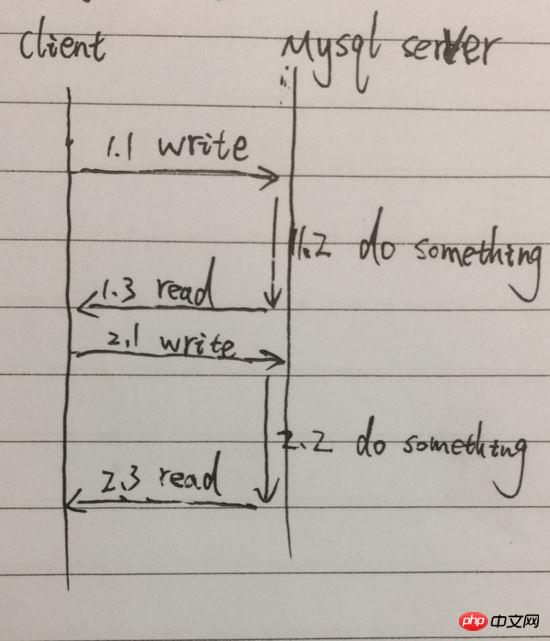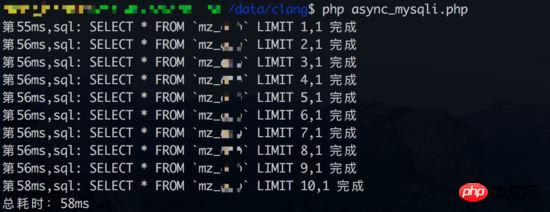PHP concurrency example about querying MySQL (picture)
This article mainly introduces the example code of PHP concurrent query of MySQL. The editor thinks it is quite good. Now I will share it with you and give it as a reference. Let’s follow the editor to take a look.
I have been studying PHP recently and I like it very much. I encountered the problem of concurrent query of MySQL in PHP. I studied it and left a note by the way:
Synchronization Query
This is our most common calling mode. The client calls Query[function], initiates a query command, waits for the result to be returned, reads the result; then sends the second query command, and waits for the result to be returned. , read the result. The total time taken will be the sum of the time of the two queries. Simplify the process, for example, as shown in the figure below:

As shown in the figure, from 1.1 to 1.3 is the call of a Query [function]. Two queries require serialization of 1.1, 1.2, 1.3, 2.1, 2.2, 2.3, especially 1.2 and 2.2 will block waiting, and the process cannot do other things.
The advantage of synchronous calling is that it conforms to our intuitive thinking and is simple to call and process. The disadvantage is that the process is blocked waiting for the result to be returned, adding extra running time.
If there are multiple query requests, or the process has other things to deal with, then it is obviously possible to make reasonable use of the waiting time and improve the processing capacity of the process.
Split
Now, we break the Query[function] into pieces. The client returns immediately after 1.1. The client skips 1.2 and has data in 1.3. Read the data after reaching it. In this way, the process is freed from the original 1.2 stage and can do more things, such as...initiate another SQL query [2.1], have you seen the prototype of concurrent query?
Concurrent query
Compared to the synchronous query, the next query is initiated after the previous query is completed. Concurrent queries can be initiated immediately after the previous query request is initiated. Initiate the next query request. Simplify the process, as shown below:

Example picture, after successfully sending the request in 1.1.1, [1.1.2] is returned immediately, and the final query result is returned in Distant 1.2. However, between 1.1.1 and 1.2, another query request was initiated. During this time period, two query requests were initiated at the same time. 2.2 arrived before 1.2, so the total time of the two queries was only equivalent to The time of the first query.
The advantage of concurrent query is that it can improve the utilization rate of the process, avoid blocking and waiting for the server to process the query, and shorten the time of multiple queries. But the disadvantages are also obvious. To initiate N concurrent queries, you need to establish N database links. For applications with database connection pools, this situation can be avoided.
Degeneration
Ideally, we want to concurrently run N queries, and the total time consumption is equal to the query with the longest query time. But it is also possible that concurrent queries will [degenerate] into [synchronous queries]. What? In the example diagram, if 1.2 is returned before 2.1.1, then the concurrent query will [degenerate] into [synchronous query], but the cost will be higher than that of synchronous query.
Multiplexing
Initiate query1
Initiate query2
Initiate query3
- ##…………
- Waiting for query1, query2, query3
- Read query2 results
- Read query1 results
- Read query3 results
PHP implements concurrent query MySQL
PHP's mysqli (mysqlnd driver) provides multiplexed polling IO (mysqli_poll) and asynchronous query (MYSQLI_ASYNC, mysqli_reap_async_query), Use these two features to implement concurrent queries, sample code:1 2 3 4 5 6 7 8 9 10 11 12 13 14 15 16 17 18 19 20 21 22 23 24 25 26 27 28 29 30 31 32 33 34 35 36 37 38 39 40 41 42 43 44 45 46 47 48 49 50 51 |
|
1 2 3 4 5 6 7 8 9 10 11 12 13 14 15 16 17 18 19 20 21 22 23 24 25 26 27 28 29 30 31 32 33 34 35 36 37 38 39 40 41 42 43 44 45 46 47 48 49 50 51 52 53 54 55 56 57 58 59 60 61 62 63 64 65 66 67 68 69 70 71 72 |
|
Concurrent query operation results
In order to see it more intuitively As a result, I found a table with 130 million data volumes and which has not been optimized for operation. 

Comparison of multiple queries with shorter query times
Use multiple sql queries with shorter query times for comparison
Concurrent query test 1 Result (database link time is also counted):

Result of synchronous query (database link time is also counted):

Test 2 results of concurrent query (database link time is not counted):

Judging from the results, concurrent query test 1 did not benefit. From the perspective of synchronous queries, each query takes about 3-4ms. But if the database connection time is not included in the statistics (synchronous query only has one database connection), the advantages of concurrent query can be reflected again.
Conclusion
Here we discussed the implementation of concurrent query MySQL in PHP, and intuitively understood the advantages and disadvantages of concurrent query from the experimental results. The time to establish a database connection still accounts for a large proportion of an optimized SQL query. #There is no connection pool, what is your use?
The above is the detailed content of PHP concurrency example about querying MySQL (picture). For more information, please follow other related articles on the PHP Chinese website!

Hot AI Tools

Undresser.AI Undress
AI-powered app for creating realistic nude photos

AI Clothes Remover
Online AI tool for removing clothes from photos.

Undress AI Tool
Undress images for free

Clothoff.io
AI clothes remover

Video Face Swap
Swap faces in any video effortlessly with our completely free AI face swap tool!

Hot Article

Hot Tools

Notepad++7.3.1
Easy-to-use and free code editor

SublimeText3 Chinese version
Chinese version, very easy to use

Zend Studio 13.0.1
Powerful PHP integrated development environment

Dreamweaver CS6
Visual web development tools

SublimeText3 Mac version
God-level code editing software (SublimeText3)

Hot Topics
 PHP and Python: Comparing Two Popular Programming Languages
Apr 14, 2025 am 12:13 AM
PHP and Python: Comparing Two Popular Programming Languages
Apr 14, 2025 am 12:13 AM
PHP and Python each have their own advantages, and choose according to project requirements. 1.PHP is suitable for web development, especially for rapid development and maintenance of websites. 2. Python is suitable for data science, machine learning and artificial intelligence, with concise syntax and suitable for beginners.
 PHP's Current Status: A Look at Web Development Trends
Apr 13, 2025 am 12:20 AM
PHP's Current Status: A Look at Web Development Trends
Apr 13, 2025 am 12:20 AM
PHP remains important in modern web development, especially in content management and e-commerce platforms. 1) PHP has a rich ecosystem and strong framework support, such as Laravel and Symfony. 2) Performance optimization can be achieved through OPcache and Nginx. 3) PHP8.0 introduces JIT compiler to improve performance. 4) Cloud-native applications are deployed through Docker and Kubernetes to improve flexibility and scalability.
 The Enduring Relevance of PHP: Is It Still Alive?
Apr 14, 2025 am 12:12 AM
The Enduring Relevance of PHP: Is It Still Alive?
Apr 14, 2025 am 12:12 AM
PHP is still dynamic and still occupies an important position in the field of modern programming. 1) PHP's simplicity and powerful community support make it widely used in web development; 2) Its flexibility and stability make it outstanding in handling web forms, database operations and file processing; 3) PHP is constantly evolving and optimizing, suitable for beginners and experienced developers.
 PHP's Purpose: Building Dynamic Websites
Apr 15, 2025 am 12:18 AM
PHP's Purpose: Building Dynamic Websites
Apr 15, 2025 am 12:18 AM
PHP is used to build dynamic websites, and its core functions include: 1. Generate dynamic content and generate web pages in real time by connecting with the database; 2. Process user interaction and form submissions, verify inputs and respond to operations; 3. Manage sessions and user authentication to provide a personalized experience; 4. Optimize performance and follow best practices to improve website efficiency and security.
 How to connect to the database of apache
Apr 13, 2025 pm 01:03 PM
How to connect to the database of apache
Apr 13, 2025 pm 01:03 PM
Apache connects to a database requires the following steps: Install the database driver. Configure the web.xml file to create a connection pool. Create a JDBC data source and specify the connection settings. Use the JDBC API to access the database from Java code, including getting connections, creating statements, binding parameters, executing queries or updates, and processing results.
 PHP in Action: Real-World Examples and Applications
Apr 14, 2025 am 12:19 AM
PHP in Action: Real-World Examples and Applications
Apr 14, 2025 am 12:19 AM
PHP is widely used in e-commerce, content management systems and API development. 1) E-commerce: used for shopping cart function and payment processing. 2) Content management system: used for dynamic content generation and user management. 3) API development: used for RESTful API development and API security. Through performance optimization and best practices, the efficiency and maintainability of PHP applications are improved.
 PHP and Python: Code Examples and Comparison
Apr 15, 2025 am 12:07 AM
PHP and Python: Code Examples and Comparison
Apr 15, 2025 am 12:07 AM
PHP and Python have their own advantages and disadvantages, and the choice depends on project needs and personal preferences. 1.PHP is suitable for rapid development and maintenance of large-scale web applications. 2. Python dominates the field of data science and machine learning.
 PHP: Handling Databases and Server-Side Logic
Apr 15, 2025 am 12:15 AM
PHP: Handling Databases and Server-Side Logic
Apr 15, 2025 am 12:15 AM
PHP uses MySQLi and PDO extensions to interact in database operations and server-side logic processing, and processes server-side logic through functions such as session management. 1) Use MySQLi or PDO to connect to the database and execute SQL queries. 2) Handle HTTP requests and user status through session management and other functions. 3) Use transactions to ensure the atomicity of database operations. 4) Prevent SQL injection, use exception handling and closing connections for debugging. 5) Optimize performance through indexing and cache, write highly readable code and perform error handling.






